If you've found my blog, you likely know I share a lot of sourdough discard recipes. And to have sourdough discard and make those recipes, you need a sourdough starter. So let's make one! This recipe for sourdough starter is great for beginners and easy to follow. I also share tips for troubleshooting common challenges with sourdough starter! You can do this!

Making a sourdough starter is not complicated and it only takes two ingredients. What it does take is patience (this process could take two weeks or more), and an ability to make adjustments based on your environment and how your starter is reacting. We'll help you through both of those!
Jump to:
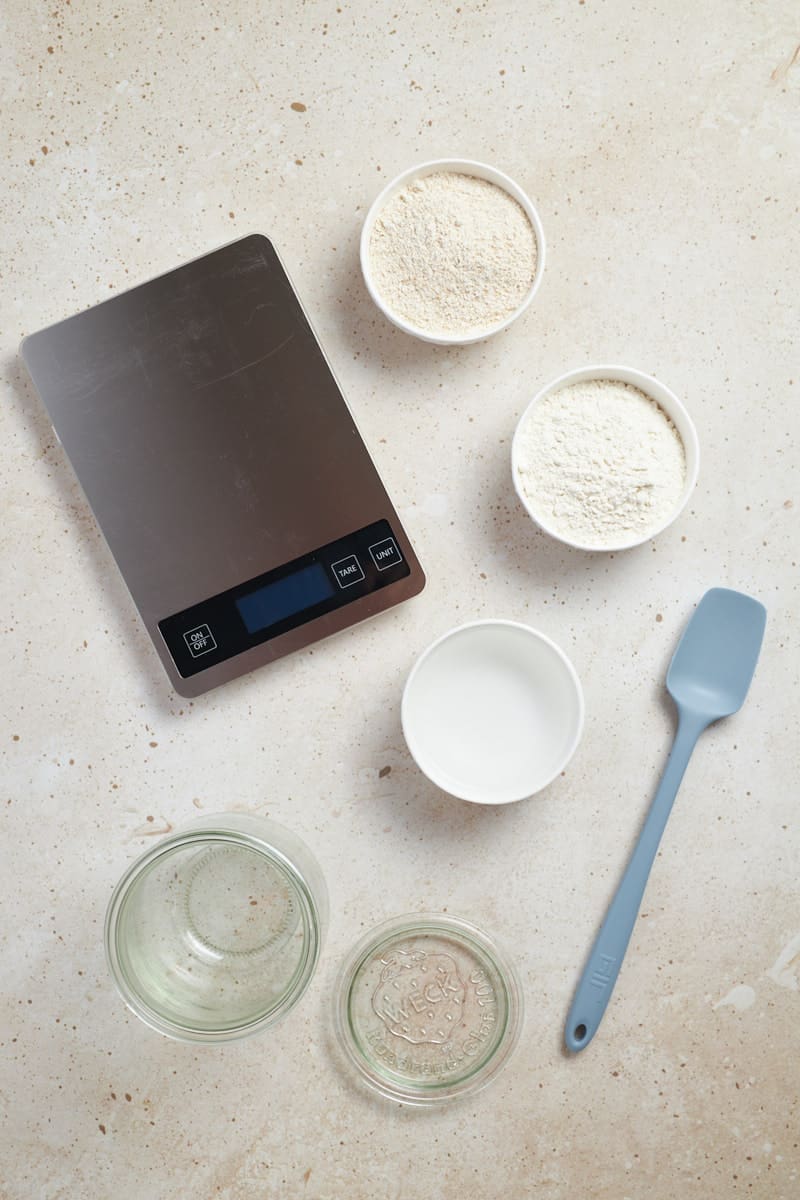
Ingredients
- Whole wheat flour: You will only use whole wheat flour in the beginning steps of making the starter. I like to use King Arthur Whole Wheat Flour, but any brand should be fine.
- Unbleached all-purpose flour: AP flour will make up the bulk of your starter, and you will go through a lot of it (so just brace for that mentally now!). Make sure this is unbleached flour. I like to use King Arthur Unbleached All-Purpose Flour, but any brand should be fine.
- Water: You can use tap, filtered or bottled water. Do not use distilled water. The starter needs some of the minerals and particles in the water!
- Honey: This is not an ingredient you will need to make your starter, but it's commonly used to help give a struggling starter a boost. It's good to have some on hand!
See full recipe below for detailed directions.
Equipment
- A glass jar: This Weck Tulip Jar is my favorite jar for sourdough starter. I use the glass lid without the rubber ring as the lid for my starter. There are a few things to consider when choosing your jar:
- Material: Glass is the best material for a sourdough starter as it's non-reactive, easy to clean, and you can easily see the starter's growth. You can also use a crock or a stone jar. You would not want to store the starter in a reactive metal container, like copper or aluminum.
- Size: You want a jar that is large enough for your starter to easily double or triple in size. I find a 32-ounce or 1-liter jar to be the ideal size.
- Opening: A jar with a wide mouth makes it easier to stir and transfer the starter in and out of the jar. It also allows for easier cleaning.
- Lid: Any "lid" should be loose to allow air in and out of the jar. You can even use a piece of plastic wrap instead of a lid.
- A kitchen scale: This is an absolute must. I do not recommend making a starter without a kitchen scale as you will be measuring your ingredients, and those measurements are important. I use a Nicewell Kitchen Scale.
- Spatulas: I like to use a GIR Skinny Spoonula to scoop my sourdough starter in and out of the jar, for mixing, etc.
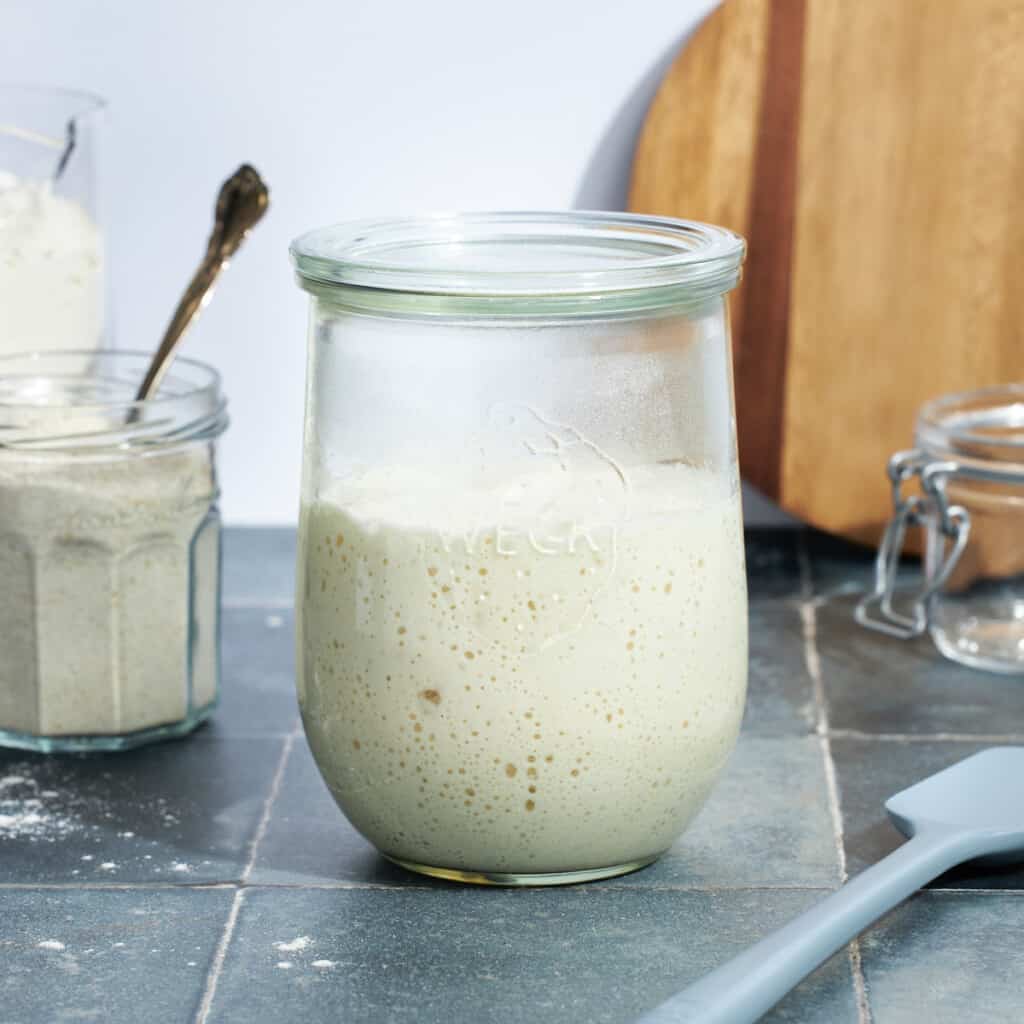
kitchen essentials
My Favorite Sourdough Starter Jar
The perfect size and shape for maintaining a sourdough starter!
How to Make a Sourdough Starter
The below steps are how I recommend making and feeding a sourdough starter.

Measure 100g whole wheat flour into a bowl on your kitchen scale.

Add 100g warm water.
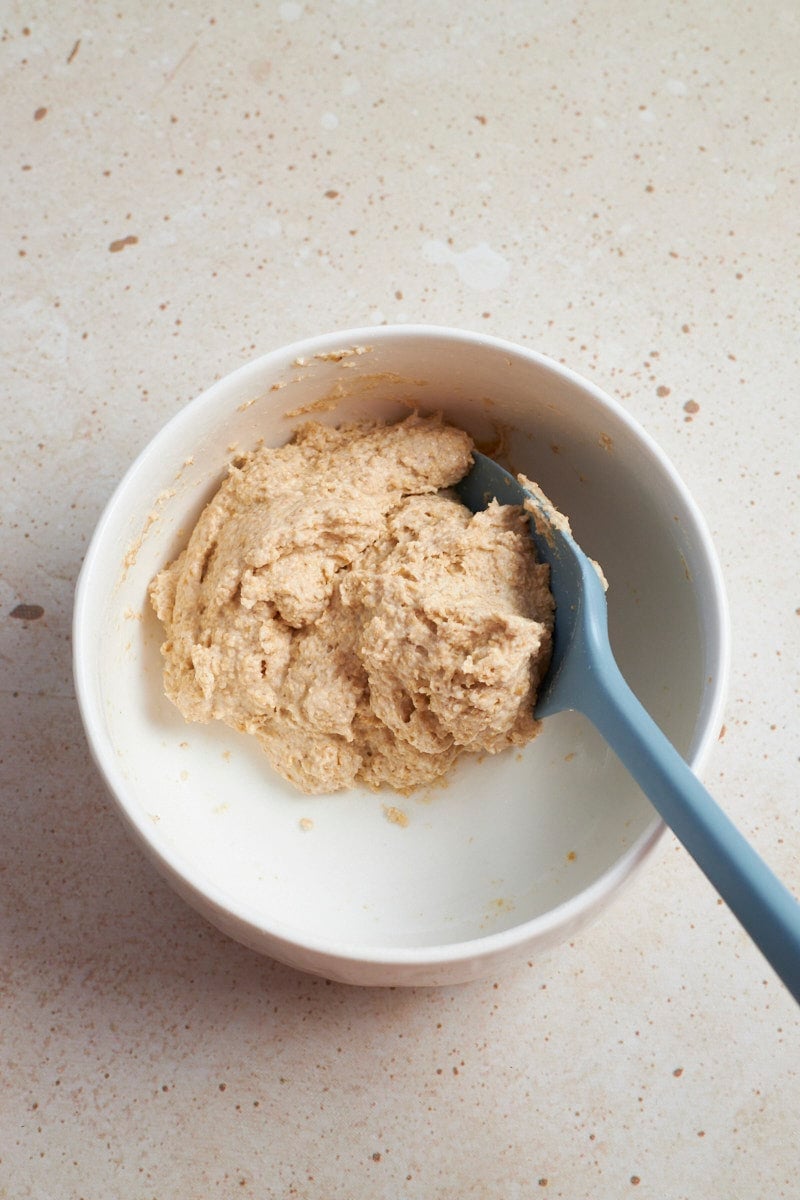
Mix together until no dry spots remain. This is your starter!

Transfer the starter mixture to a glass jar and cover. Loosely cover and let sit for 24 hours at room temperature before feeding.
Expert Baking Tips
- Measure your ingredients with a kitchen scale. This ensures consistency with your feeds.
- Use warm water. Using warm water helps boost the starter and can make a big difference in your starter growth.
- If you live in a warm or humid environment (Florida, for example), this might not work for you! Your starter may tend to be overactive, and using warm water could make this worse. In that case, you could try room-temperature water or even cooler to help control the starter.
- Your Day 1 starter will look very different! Since we are using whole wheat flour, the starter will be brown. As you feed the starter in subsequent days with all-purpose flour, the starter will turn white. Day 1 starter is also much drier than an established sourdough starter.
- OPTIONAL: Wash your jar with each feed. This is optional, but I recommend it! Personally, I don't like it when the jar gets all crusty. And cleaning dried-on starter is tough. If you clean the jar with every feed, then it will always feel fresh.
Sourdough Starter Ratios
You will often see sourdough starter spoken about in terms of ratios. This recipe makes a sourdough starter with a 1:1 ratio (also called a 1:1:1 ratio). That means when you feed your starter, it's with 1 part starter, 1 part flour, and 1 part water. This could be 50g flour / 50g water or 150g flour / 150g water. Either way, it's a 1:1 ratio since you're using equal amounts of each ingredient.
Other ratios you might hear about:
- A 1:2:2 ratio means when you feed your starter it's with 1 part starter, 2 parts flour and 2 parts water. The flour:water ratio is still the same, but you're feeding the starter with more ingredients.
- A 1:3:3 ratio means when you feed your starter it's with 1 part starter, 3 parts flour and 3 parts water. Again, the flour:water ratio is the same, but this is feeding the starter with even more ingredients.
Can you change sourdough ratios? Yes, but you typically want to pick one and stick with it so you know the makeup of your sourdough starter and it's easier to bake with. 1:1:1 is a very common sourdough ratio.
Why would you change sourdough ratios? Adjusting the ratio may work better for your starter, given the environment and the flavor that you wish to achieve.

Day 1 sourdough starter in a glass jar.
When is my sourdough starter ready to use?
Your sourdough starter is ready once it hits two milestones:
- Doubling consistently: When your starter is consistently doubling within a few hours of feeding (approximately 4-6 hours), it is ready to use. Make sure this is consistent, and happening after several feeds in a row (not just once). The starter will look light and bubbly, with bubbles on the sides and surface. This indicates a healthy, active starter that is ready to use.
- Passing the float test: You can also scoop a spoonful of your starter into a glass of water to see if it floats. If it does, your starter is light, airy, and ready to use.
Once it's ready, your sourdough starter can be used for any kind of sourdough baking.
How to Store Sourdough Starter
While you are making your starter, you will store it at room temperature. Once your starter is established, you have a few options for storage:
- Room Temperature Storage: You can continue to store your starter at room temperature and feed it (or use it) every 24 hours.
- To Feed: Feed the starter after it has fallen using the feeding directions from Day 2 below.
- Feeding Frequency: Every 24 hours
- Refrigerator Storage: If you want to use your starter less frequently, store the starter in the refrigerator.
- To Feed: Let the starter come to room temperature, then feed using the feeding directions from Day 2 below.
- Feeding Frequency: Recommended weekly (you can go up to 2 weeks without feeding).
- If you want to store your starter long-term, you can also freeze your sourdough starter, or dehydrate your sourdough starter. These are not storage methods for a starter you want to use regularly.

How to use Sourdough Discard
You can start using the sourdough discard after 7 days of making a new starter. In those first days, the discard should be literally discarded (either compost or trash).
After that, discard can be stored in an airtight container in the refrigerator. I recommend using discard within 1-2 weeks to avoid any potential mold growth. Check out this in-depth post on how to use sourdough discard for more detail.
Once you're ready to use it, sourdough discard can be used for any of these sourdough discard recipes, including a few of my favorites:
Common Sourdough Starter Challenges
There are a few common challenges that come up when making a sourdough starter:
- The jar is too small. Make sure your jar allows room for your starter to double or even triple in size. If you use a jar that is too small, your starter may overflow.
- The lid is too tight. If your lid is tight-fitting, it doesn't allow any air in or out of the jar. To make a starter, you need to allow air both in and out! Instead of a lid, try a loosely placed piece of plastic wrap, or the lid lightly placed on top of the jar rather than sealed.
- The water is too warm / cool. Warm water makes a huge difference! Try adjusting the temperature of your water as you're feeding the starter. Use warmer water if your starter isn't very active, and use cooler water if your starter is over-active.
- The environment is too warm / cool. Sourdough starter likes to be in an environment that is about 70-75 degrees F.
- If your room is cooler, place the starter in an area that is warmer (perhaps near a window or near the oven). You can also use a trivet or towel to keep the starter off the countertops, which are often cooler.
- If your room is warmer, place the starter in an area that is cooler (perhaps in the pantry away from windows).
- Have patience! Making a sourdough starter takes time, so don't give up!
For more, check out this in-depth post on tips for struggling sourdough starter.
Recipe FAQ
This is hooch and it is harmless. This means that the starter is hungry. You can mix this in the next time you feed your starter.
A sourdough starter is a fermentation of flour and water. It's going to have a smell! The smell will likely change throughout the process of making your starter. It might smell acidic, yeasty, vinegary, sweet, or even like rotten eggs. All of these smells are a good sign that there is healthy activity!
Generally, you want to watch for signs of mold. Mold can look like traditional, grey, green, or black fuzzy mold, or it could show itself as orange or pink streaks in the starter. If you see an indication of mold, your starter has gone bad and you will need to start over.
You don't need to, but I like to and would recommend it! This keeps the jar clean, easier to see through, and then there are no hard crusty bits.
Dried starter can be very hard and crusty in the jar. If you soak the jar in warm water, it will come off easily! No heavy scrubbing is needed.
In the first several days of making a starter, you won't keep the discard. You can either compost it or throw it away. Do not wash the discard down your kitchen sink drain. It hardens (you've likely noticed this on your sourdough jar!) and will clog up your pipes.
After the first 7 days, you can keep the sourdough discard in an airtight container in the refrigerator and use it for sourdough discard recipes. It can also be used as a backup sourdough starter, or you can give some to a friend or neighbor who would like to have their own starter!

Sourdough Starter Recipe
Equipment
- Weck Tulip Jar or other large jar
Ingredients
To Begin Starter (Day 1)
- 100 g whole wheat flour
- 100 g warm water
To Feed Starter (Day 2+)
- 100 g unbleached all-purpose flour
- 100 g warm water
Instructions
Make your starter (Day 1)
- Combine 100g whole wheat flour and 100g warm water in a small bowl. Mix until no dry spots remain. Transfer the mixture to a clean sourdough starter jar.
- Loosely cover the jar (a loose piece of plastic wrap works well - it's important that air can flow in and out of the jar) and let the mixture sit at room temperature (about 70-75℉) for 24 hours.
Feed your starter
- Day 2. Measure 100g of starter into a bowl. Discard the remaining starter in the jar (in the trash or compost) and clean your jar (optional). Add 100g unbleached all-purpose flour and 100g warm water to the bowl with the starter. Mix together until no dry spots remain. Transfer back to the jar, lightly cover, and let sit at room temperature for 24 hours.
- Day 3. You're likely seeing some activity at this point (bubbles, slight rising, an aroma), which is great! Now we will start feeding the starter twice per day, every 12 hours (so be strategic about what times make sense with your schedule!). To feed, measure 100g of starter into a bowl. Discard the remaining starter in the jar and clean your jar (optional). Add 100g unbleached all-purpose flour and 100g warm water to the bowl with the starter. Mix thoroughly, transfer back to the jar, lightly cover, and let sit at room temperature for 12 hours before the next feeding.
- Day 4. Repeat the feeding directions from Day 3, feeding every 12 hours.
- Day 5. Repeat the feeding directions from Day 3, feeding every 12 hours.
- Day 6. Repeat the feeding directions from Day 3, feeding every 12 hours.
- Day 7+. At this point, you may be seeing significant activity with your starter consistently doubling in size and lots of bubbles. If your starter has doubled in size with each feeding for 2-3 days, you can consider your starter to be established! You can now use your starter for baking and shift to storing your starter (see the Storage section above). If you're not seeing that activity yet, that's ok and completely normal! Continue repeating the feeding directions from Day 3, feeding every 12 hours, for Day 6, 7, 8+. If you are reaching Day 10-12 and still not seeing significant activity, see the Common Sourdough Challenges section above. It can take 2-3 weeks to create a healthy starter. Keep going!



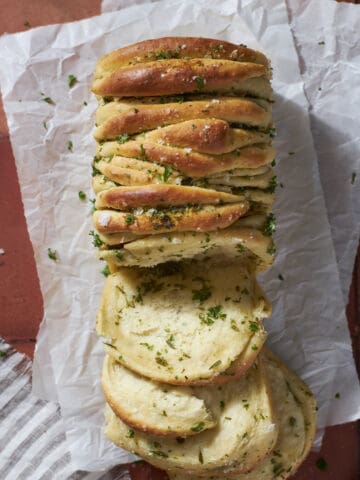




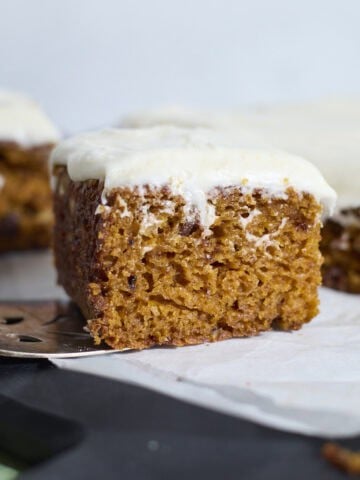
Diana says
You said to wash your jar every time you feed? What do you do with your starter while you’re cleaning the jar? This is a whole new experience for me so I want to do it correctly. Forgive me if this is a dumb question.
Jessica Vogl says
I typically feed my starter in a bowl, so the portion that will get fed is in a bowl, and the discard goes into a container (or compost / trash). While my starter is in the bowl, I'll clean my jar!
layla says
do you want to wait til the starter is active to store the discard for recipes?
Jessica Vogl says
You don't want to use discard from the first 8 days of making a new sourdough starter, but it doesn't need to be completely up and active yet.
Jess K says
Can you change the ratios to 50:50:50 if not baking a lot that week
Jessica Vogl says
For getting your starter up and running, I would pick one measurement you want to stick with (could be 100g, 50g, any other number). The key here is that the ratio is the same. Feeding 100g starter with 100g flour and 100g water is the same ratio as feeding 50g starter with 50g flour and 50g water. Overall, the 50g version will give you a smaller starter. Once your starter is established and rising consistently, then yes, you can easily increase or decrease the size of your starter in this way!
Melinda says
Can I use 50g of whole wheat flour and 50g of AP white flour? still equal out to 1:1:1 ratio.
Jessica Vogl says
Yes, that should be fine! The whole wheat flour will actually give your starter a boost, so hopefully you'll see activity even quicker!
Tesia says
When we take out of refrigerator are we still discarding all but 100 grams ?
Jessica Vogl says
Anytime you are feeding your starter (whether it's coming from the refrigerator or it's being stored at room temperature), you will discard all but 100g starter. To that 100g starter, you will add 100g AP flour and 100g warm water. Hope that helps!
Paula says
I am very excited to start this new journey into sourdough. Thank you for all of the valuable information.